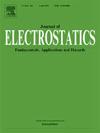Invited Paper: Liquid flow electrification phenomenon: Review
IF 2.1
4区 工程技术
Q3 ENGINEERING, ELECTRICAL & ELECTRONIC
引用次数: 0
Abstract
Flow electrification phenomenon is particularly complex as it involves materials, physics, chemistry, and fluid mechanics. It originates from the electric double layer (EDL) present at each solid/liquid interface, which results in a polarization of the interface. This physics equilibrium is determined by the nature of the materials and their physico-chemical properties. It is disrupted by the liquid flow toward a new equilibrium, described by the flow electrification phenomenon. Studied within the research framework in electrochemistry, colloid chemistry, and electrical engineering, EDL remains poorly understood. It relies on models whose viability has yet to be confirmed, as well as on often indirect experimental approaches. Zeta-metry and the flow electrification measurements constitute the main methods of study.
The evaluation and control of electrostatic hazard in an industrial and applied context can be achieved either by acting on the genesis of charge generation at interfaces or by addressing the various parameters governing the phenomenon of electrification through flow. Thus, after a description of the EDL, the phenomenon of electrification through flow will be analyzed in detail for both laminar and turbulent regimes. Particular attention will be given to studying this phenomenon in the context of electrostatic hazard in power transformers. Then, a new theoretical analysis of the flow electrification phenomenon under turbulent flows is described. Finally, an overview of new experimental approaches for analyzing the EDL will be presented.
特邀论文:液体流动带电现象:综述
流动起电现象是一个涉及材料、物理、化学、流体力学等多个学科的复杂现象。它起源于每个固/液界面上存在的双电层(EDL),这导致了界面的极化。这种物理平衡是由材料的性质及其物理化学性质决定的。它被液体向新的平衡流动所破坏,这种平衡被流动带电现象所描述。在电化学、胶体化学和电气工程的研究框架内,对EDL的了解仍然很少。它依赖于可行性尚未得到证实的模型,以及通常是间接的实验方法。泽塔法和流电法是研究的主要方法。在工业和应用环境中,对静电危害的评价和控制可以通过在界面上产生电荷的起因来实现,也可以通过处理控制通过流动的带电现象的各种参数来实现。因此,在描述了EDL之后,将详细分析层流和湍流状态下通过流动产生的通电现象。将特别注意在电力变压器静电危害的背景下研究这一现象。然后,对紊流下的流动起电现象进行了新的理论分析。最后,将概述分析EDL的新实验方法。
本文章由计算机程序翻译,如有差异,请以英文原文为准。
求助全文
约1分钟内获得全文
求助全文
来源期刊

Journal of Electrostatics
工程技术-工程:电子与电气
CiteScore
4.00
自引率
11.10%
发文量
81
审稿时长
49 days
期刊介绍:
The Journal of Electrostatics is the leading forum for publishing research findings that advance knowledge in the field of electrostatics. We invite submissions in the following areas:
Electrostatic charge separation processes.
Electrostatic manipulation of particles, droplets, and biological cells.
Electrostatically driven or controlled fluid flow.
Electrostatics in the gas phase.
 求助内容:
求助内容: 应助结果提醒方式:
应助结果提醒方式:


